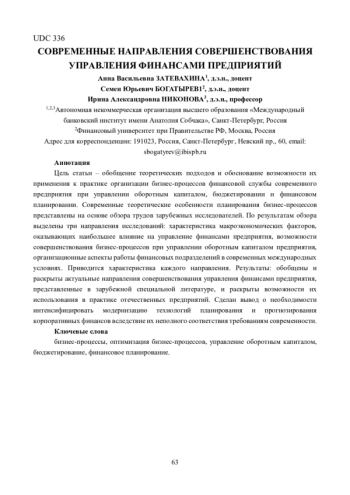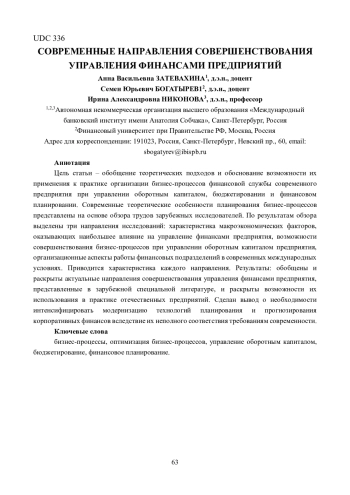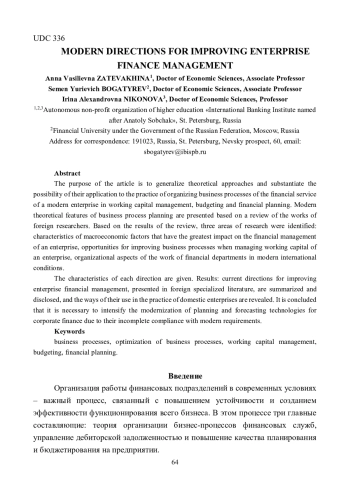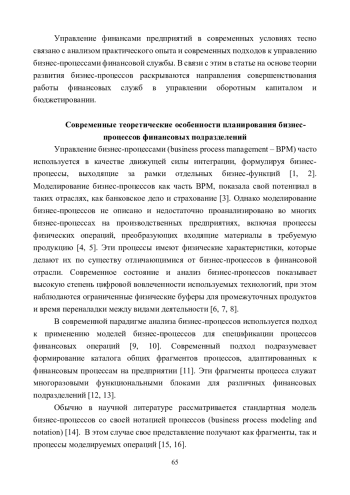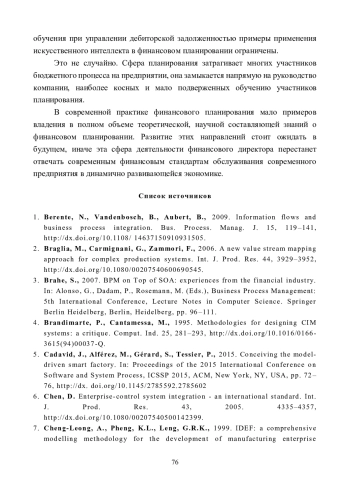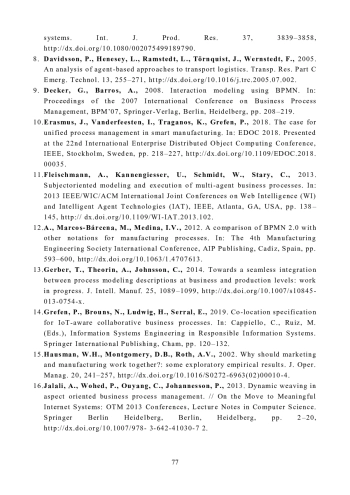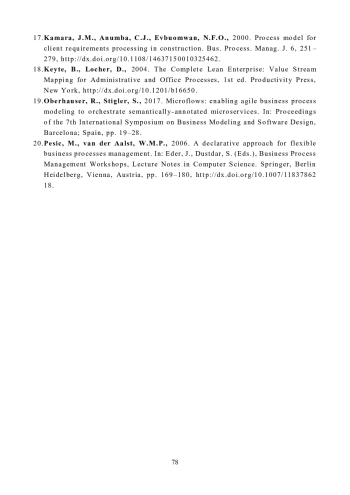The purpose of the article is to generalize theoretical approaches and substantiate the possibility of their application to the practice of organizing business processes of the financial service of a modern enterprise in working capital management, budgeting and financial planning. Modern theoretical features of business process planning are presented based on a review of the works of foreign researchers. Based on the results of the review, three areas of research were identified: characteristics of macroeconomic factors that have the greatest impact on the financial management of an enterprise, opportunities for improving business processes when managing working capital of an enterprise, organizational aspects of the work of financial departments in modern international conditions. The characteristics of each direction are given.
Results: current directions for improving enterprise financial management, presented in foreign specialized literature, are summarized and disclosed, and the ways of their use in the practice of domestic enterprises are revealed. It is concluded that it is necessary to intensify the modernization of planning and forecasting technologies for corporate finance due to their incomplete compliance with modern requirements.
1. Berente, N., Vandenbosch, B., Aubert, B., 2009. Information flows and business process integration. Bus. Process. Manag. J. 15, 119 -141,. DOI: 10.1108/14637150910931505
2. Braglia, M., Carmignani, G., Zammori, F., 2006. A new value stream mapping approach for complex production systems. Int. J. Prod. Res. 44, 3929-3952,. DOI: 10.1080/00207540600690545
3. Brahe, S., 2007. BPM on Top of SOA: experiences from the financial industry. In: Alonso, G., Dadam, P., Rosemann, M. (Eds.), Business Process Management: 5th International Conference, Lecture Notes in Computer Science. Springer Berlin Heidelberg, Berlin, Heidelberg, pp. 96 -111.
4. Brandimarte, P., Cantamessa, M., 1995. Methodologies for designing CIM systems: a critique. Comput. Ind. 25, 281 -293,. DOI: 10.1016/0166-3615(94)00037-Q EDN: APDWMH
5. Cadavid, J., Alferez, M., Gerard, S., Tessier, P., 2015. Conceiving the model-driven smart factory. In: Proceedings of the 2015 International Conference on Software and System Process, ICSSP 2015, ACM, New York, NY, USA, pp. 72 -76,. DOI: 10.1145/2785592.2785602
6. Chen, D. Enterprise-control system integration - an international standard. Int. J. Prod. Res. 43, 2005. 4335-4357,. DOI: 10.1080/00207540500142399
7. Cheng-Leong, A., Pheng, K.L., Leng, G.R.K., 1999. IDEF: a comprehensive modelling methodology for the development of manufacturing enterprise systems. Int. J. Prod. Res. 37, 3839-3858,. DOI: 10.1080/002075499189790
8. Davidsson, P., Henesey, L., Ramstedt, L., Tornquist, J., Wernstedt, F., 2005. An analysis of agent-based approaches to transport logistics. Transp. Res. Part C Emerg. Technol. 13, 255-271,. DOI: 10.1016/j.trc.2005.07.002
9. D ecker, G., Barros, A., 2008. Interaction modeling using BPMN. In: Proceedings of the 2007 International Conference on Business Process Management, BPM’07, Springer-Verlag, Berlin, Heidelberg, pp. 208-219.
10. Erasmus, J., Vanderfeesten, I., Traganos, K., Grefen, P., 2018. The case for unified process management in smart manufacturing. In: EDOC 2018. Presented at the 22nd International Enterprise Distributed Object Computing Conference, IEEE, Stockholm, Sweden, pp. 218-227,. DOI: 10.1109/EDOC.2018.00035
11. Fleischmann, A., Kannengiesser, U., Schmidt, W., Stary, C., 2013. Subjectoriented modeling and execution of multi-agent business processes. In: 2013 IEEE/WIC/ACM International Joint Conferences on Web Intelligence (WI) and Intelligent Agent Technologies (IAT), IEEE, Atlanta, GA, USA, pp. 138 -145,. DOI: 10.1109/WI-IAT.2013.102
12. A., Marcos-Barcena, M., Medina, I.V., 2012. A comparison of BPMN 2.0 with other notations for manufacturing processes. In: The 4th Manufacturing Engineering Society International Conference, AIP Publishing, Cadiz, Spain, pp. 593-600,. DOI: 10.1063/L4707613
13. Gerber, T., Theorin, A., Johnsson, C., 2014. Towards a seamless integration between process modeling descriptions at business and production levels: work in progress. J. Intell. Manuf. 25, 1089 -1099,. DOI: 10.1007/s10845-013-0754-x
14. Grefen, P., Brouns, N., Ludwig, H., Serral, E., 2019. Co-location specification for IoT-aware collaborative business processes. In: Cappiello, C., Ruiz, M. (Eds.), Information Systems Engineering in Responsible Information Systems. Springer International Publishing, Cham, pp. 120-132.
15. Hausman, W.H., Montgomery, D.B., Roth, A.V., 2002. Why should marketing and manufacturing work together?: some exploratory empirical results. J. Oper. Manag. 20, 241 -257,. DOI: 10.1016/S0272-6963(02)00010-4 EDN: DZZGRV
16. Jalali, A., Wohed, P., Ouyang, C., Johannesson, P., 2013. Dynamic weaving in aspect oriented business process management. // On the Move to Meaningful Internet Systems: OTM 2013 Conferences, Lecture Notes in Computer Science. Springer Berlin Heidelberg, Berlin, Heidelberg, pp. 2-20,. DOI: 10.1007/978-3-642-41030-72
17. Kamara, J.M., Anumba, C.J., Evbuomwan, N.F.O., 2000. Process model for client requirements processing in construction. Bus. Process. Manag. J. 6, 251 -279,. DOI: 10.1108/14637150010325462 EDN: EBKRGT
18. Keyte, B., Locher, D., 2004. The Complete Lean Enterprise: Value Stream Mapping for Administrative and Office Processes, 1 st ed. Productivity Press, New York,. DOI: 10.1201/b16650
19. Oberhauser, R., Stigler, S., 2017. Microflows: enabling agile business process modeling to orchestrate semantically-annotated microservices. In: Proceedings of the 7th International Symposium on Business Modeling and Software Design, Barcelona; Spain, pp. 19-28.
20. Pesic, M., van der Aalst, W.M.P., 2006. A declarative approach for flexible business processes management. In: Eder, J., Dustdar, S. (Eds.), Business Process Management Workshops, Lecture Notes in Computer Science. Springer, Berlin Heidelberg, Vienna, Austria, pp. 169 -180,. DOI: 10.1007/11837862
